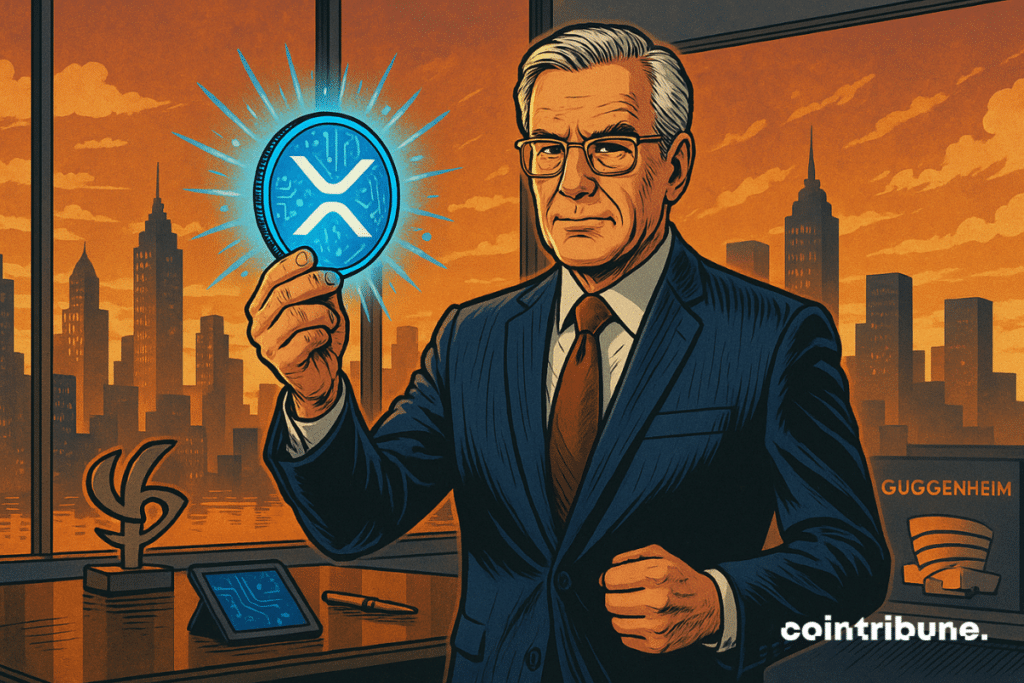Apex 2025: Digital Commercial Paper DCP is now live on the XRP Ledger. Administered by Guggenheim Treasury Services, one of the largest independent commercial paper platform managers in the world and powered by Zeconomy: https://t.co/Ic4YdUnNry
— RippleX (@RippleXDev) June 10, 2025
With $280M+ in issuance, DCP is…
A
A
Crypto: Guggenheim Adopts the XRP Ledger!
Thu 12 Jun 2025 ▪
4
min read ▪ by
Getting informed
▪
Summarize this article with:
When a Wall Street institution migrates to a public blockchain, it is no longer an experiment; it is a shift. By issuing its debt securities on the XRP Ledger, Guggenheim Treasury Services not only validates Ripple’s infrastructure but also redefines the contours of market finance. This operation marks a concrete advance in the tokenization of real-world assets and confirms the progressive anchoring of decentralized finance at the heart of institutional strategies.

In Brief
- Guggenheim chooses the XRP Ledger to tokenize its short-term debt product, a major institutional first for Ripple.
- The Digital Commercial Paper (DCP) is backed by U.S. Treasury bills and rated Prime-1 by Moody’s, ensuring security and credibility.
- The Zeconomy platform enables compliant and seamless integration of the DCP on the XRP Ledger, with use cases such as real-time settlement or collateral mobilization.
- Ripple continues its strategy of tokenizing real-world assets, relying on initiatives like Ondo, Archax, and now Guggenheim.
Guggenheim Bets on the XRP Ledger for Its Tokenized Debt
Following the launch of XRP futures by CME GROUP, Guggenheim Treasury Services, a well-established player in the short-term debt securities universe, has taken a major technological step on June 10.
Indeed, its flagship product, the Digital Commercial Paper (DCP), becomes the first native commercial paper issued on the XRP Ledger.
This operation is made possible thanks to Zeconomy, a platform bridging traditional finance and blockchain. The DCP is a short-term debt product supported by U.S. Treasury bills and rated Prime-1 by Moody’s.
It is aimed at institutional clients seeking safe investments, but with a now fully digital and instantaneous treatment on the XRPL.
The key points to remember from this operation are as follows:
- Type of asset: it is a digital commercial paper, backed by U.S. Treasury bills, rated Prime-1 (the best short-term rating) by Moody’s;
- Infrastructure: the DCP is now natively issued on the XRP Ledger, thanks to the infrastructure of Zeconomy, specialized in regulatory compliance and tokenization;
- Volume handled: the product has already processed over 280 million dollars in transactions since its launch at the end of 2024;
- Objective: to facilitate real-time settlements, cash management, cross-border payments, and asset mobilization as collateral;
- Strategic challenge: this is a historic first on the XRPL and a notable advance for Ripple in its desire to tokenize real-world assets for institutions.
This operation, technically ambitious and legally structured, positions the XRPL as a serious blockchain infrastructure for hosting regulated financial assets. The integration of the DCP could well open the way for other similar initiatives at the institutional level.
Zeconomy and Ripple, the Spearheads of Tokenized Finance
At the heart of this operation lies Zeconomy, an infrastructure designed to transpose traditional financial assets into a blockchain environment. The company plays a central role in the passage of the DCP onto the XRP Ledger by providing the infrastructure, governance, and necessary regulatory safeguards.
The new development on XRPL is supported through Zeconomy, which provides the infrastructure and compliance required by institutions. Thus, it is not just a simple “token” launched on a network, but a structured and compliant integration, designed to meet the demands of the most conservative financial players.
This movement is part of a strategy led by Ripple, which seeks to position the XRPL as a vehicle for issuing real-world assets, complementing other existing initiatives on the ledger, such as the projects Ondo or Archax.
By focusing on the tokenization of sovereign or quasi-sovereign debts, Ripple aims to attract institutional liquidity by offering regulated assets immediately usable for settlement, treasury, or financing.
In the long term, this operation could strengthen the credibility of the XRPL as a financial infrastructure layer for the tokenization of real assets. If other institutions follow Guggenheim’s example, the XRP Ledger could become a central player in decentralized finance, a role so far dominated by Ethereum and some L2 solutions.
Maximize your Cointribune experience with our "Read to Earn" program! For every article you read, earn points and access exclusive rewards. Sign up now and start earning benefits.
A
A
Diplômé de Sciences Po Toulouse et titulaire d'une certification consultant blockchain délivrée par Alyra, j'ai rejoint l'aventure Cointribune en 2019. Convaincu du potentiel de la blockchain pour transformer de nombreux secteurs de l'économie, j'ai pris l'engagement de sensibiliser et d'informer le grand public sur cet écosystème en constante évolution. Mon objectif est de permettre à chacun de mieux comprendre la blockchain et de saisir les opportunités qu'elle offre. Je m'efforce chaque jour de fournir une analyse objective de l'actualité, de décrypter les tendances du marché, de relayer les dernières innovations technologiques et de mettre en perspective les enjeux économiques et sociétaux de cette révolution en marche.
DISCLAIMER
The views, thoughts, and opinions expressed in this article belong solely to the author, and should not be taken as investment advice. Do your own research before taking any investment decisions.